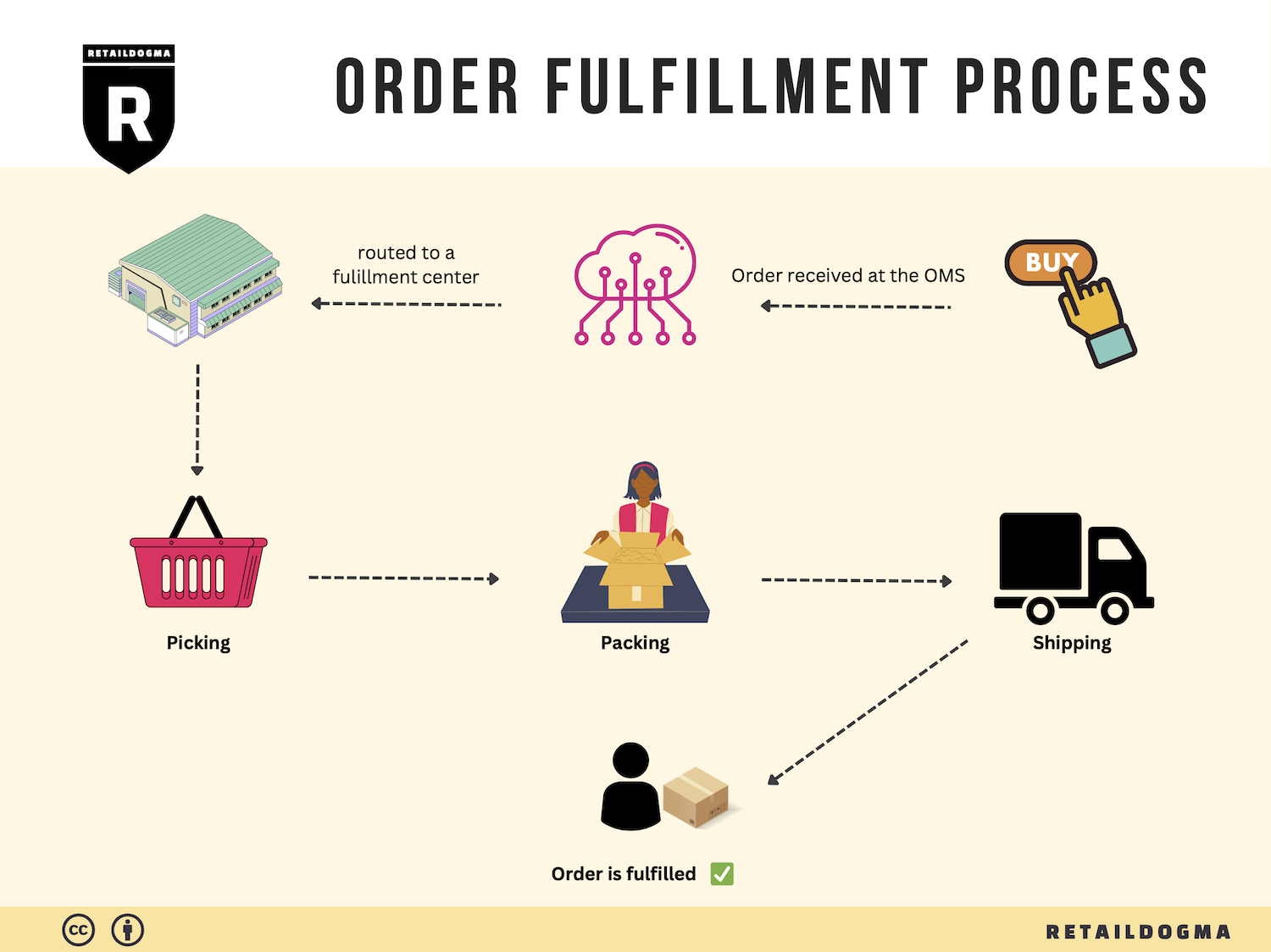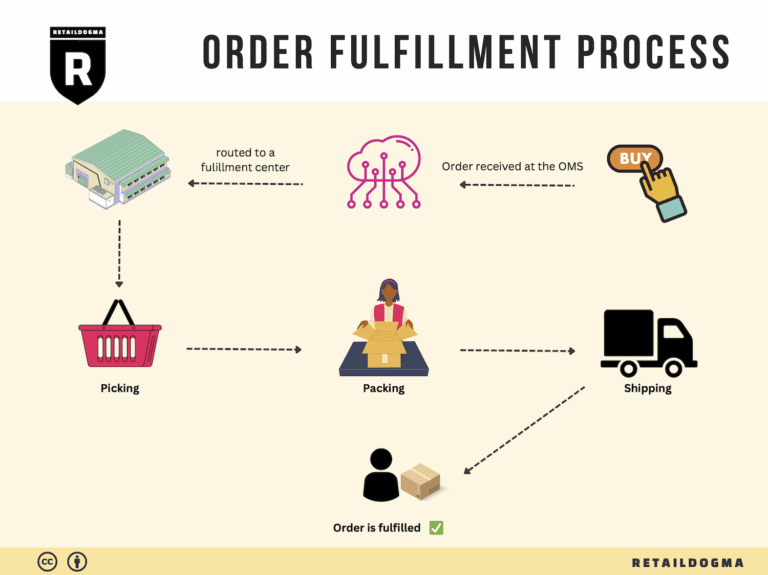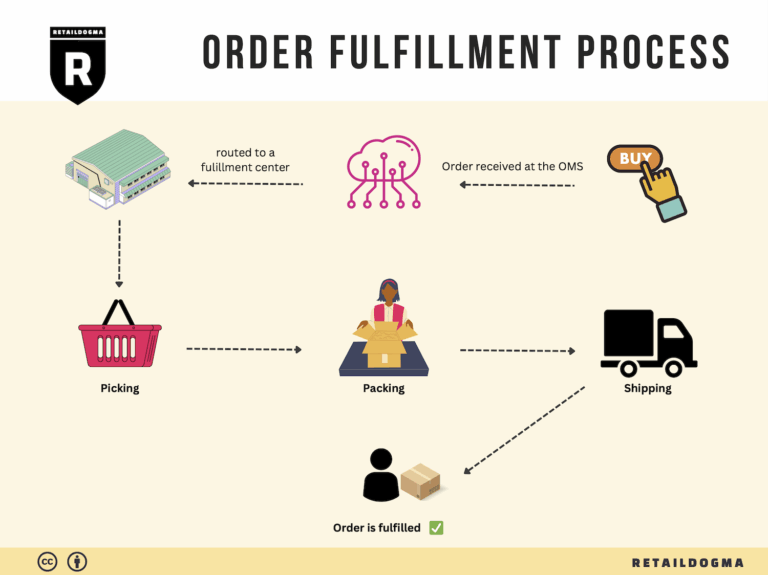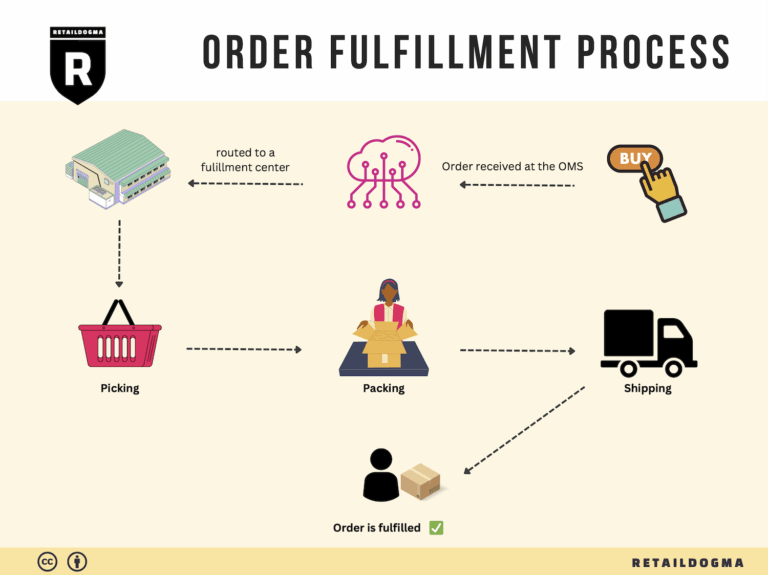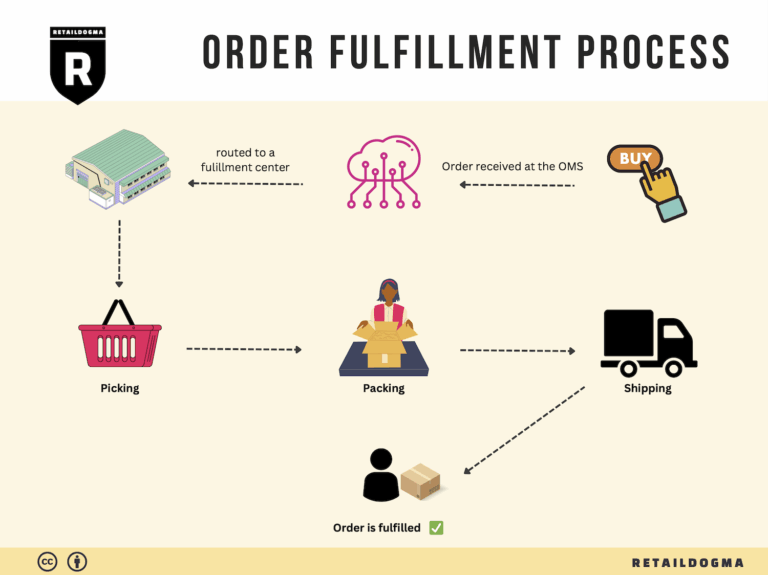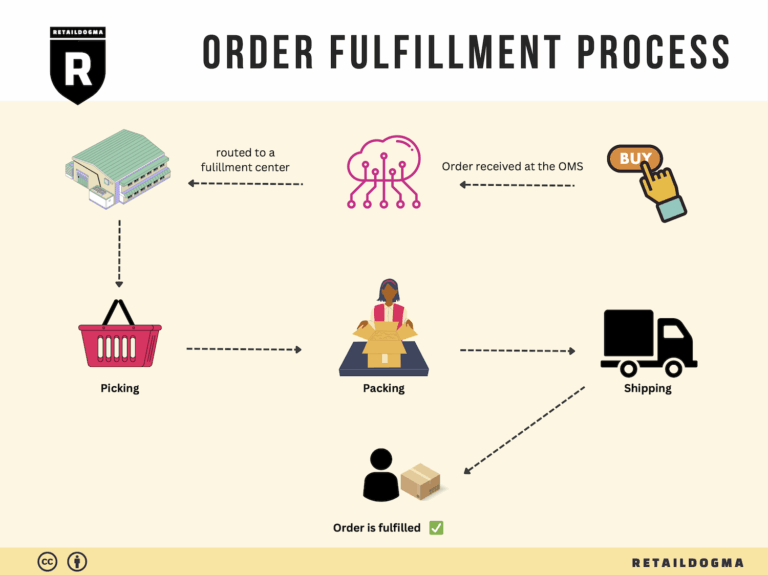Ecommerce Fulfillment Services: The Ultimate Guide (2025)
What is E-commerce Fulfillment? An Introduction for Growing Businesses
As an e-commerce business owner, managing the logistics of packing and shipping orders can quickly become overwhelming. You’re not alone—many growing online retailers struggle with the demands of fulfillment, especially as sales begin to scale. The process of getting a product from your warehouse to your customer’s doorstep encompasses everything from order processing to shipping, and it can often feel like a daunting task.
Understanding Fulfillment
In simple terms, e-commerce fulfillment is the process of receiving, processing, and delivering orders to customers. This includes inventory management, order processing, packaging, shipping, and handling returns. As your business grows, the complexity of these tasks increases, requiring more efficient systems and resources.
What This Guide Will Cover
This guide aims to demystify e-commerce fulfillment by exploring the various models available to businesses today. We will discuss popular options such as Third-Party Logistics (3PL) and Fulfillment by Amazon (FBA), highlighting the pros and cons of each to help you determine which model aligns best with your business needs.
Additionally, we will delve into the core services that fulfillment partners typically provide, including inventory management, kitting, and customer service. Understanding these services will empower you to assess potential partners effectively.
Choosing the right fulfillment partner is crucial for your business’s success. We’ll provide practical tips on what to look for when selecting a logistics partner, including factors like scalability, technology integration, and customer support.
Finally, we’ll touch on pricing structures associated with different fulfillment services, so you can evaluate costs against your budget and growth projections.

Empowering Smart Decisions
The ultimate goal of this guide is to empower you to make informed decisions about your logistics operations. By understanding the intricacies of e-commerce fulfillment, you can streamline your processes, improve customer satisfaction, and focus on what truly matters—growing your business. With the right knowledge and partner, fulfillment can transform from a pain point into a competitive advantage.
What You’ll Learn In This Guide
- What is E-commerce Fulfillment? An Introduction for Growing Businesses
- The Order Fulfillment Process: From ‘Buy’ Button to Customer’s Door
- Comparing Fulfillment Models: In-House vs. 3PL vs. Dropshipping
- A Deep Dive into Amazon FBA: Pros, Cons, and Who It’s For
- Core Services Offered by Fulfillment Centers
- How to Choose a Fulfillment Partner: A 6-Point Checklist
- Understanding Fulfillment Pricing: A Breakdown of Common Fees
- Frequently Asked Questions (FAQs) about Fulfillment
- Conclusion: Is Outsourcing Fulfillment the Right Move for Your Business?
- Important Disclaimer
The Order Fulfillment Process: From ‘Buy’ Button to Customer’s Door
1. Receiving Inventory
The first step in the order fulfillment process begins when inventory arrives at your warehouse. During this stage, items are checked against the purchase order to ensure accuracy in quantity and condition. This process often involves recording key information such as Stock Keeping Units (SKUs), which serve as unique identifiers for each product.
Receiving inventory is critical because it sets the foundation for the entire fulfillment operation. Any discrepancies or damages noted at this stage can be addressed before products enter the storage system, thereby reducing future complications. Properly managing inventory upon receipt helps maintain accurate stock levels and ensures that your inventory management system is up-to-date. This stage is essential for preventing stockouts or overstock situations that can lead to lost sales or increased holding costs.
2. Warehouse Storage
Once the inventory is received and verified, the next step involves storing products in the warehouse. This process includes organizing items based on their size, type, or sales frequency to optimize space and efficiency. Key terms associated with this step include “bin location” and “inventory management system,” which help in tracking where products are stored within the warehouse.
Effective warehouse storage is vital for maximizing space and improving order retrieval times. An organized storage system allows for quicker access to products, which is essential for maintaining high fulfillment speed. Additionally, using technology such as barcode scanning or RFID can further enhance accuracy in inventory tracking and reduce human error, leading to a more efficient overall operation.
3. Order Picking
The order picking stage is where items are selected from the warehouse to fulfill customer orders. This process typically utilizes pick lists—documents that outline the items and quantities needed for each order. Depending on the scale of operations, businesses may employ various picking methods, such as single order picking, batch picking, or zone picking.
Order picking is crucial because it directly impacts order accuracy and fulfillment speed. A well-executed picking process minimizes the chances of errors, such as sending the wrong item or quantity to a customer, which can lead to returns and decreased customer satisfaction. Implementing technology such as pick-to-light systems or mobile devices can streamline this process, making it more efficient and error-resistant.
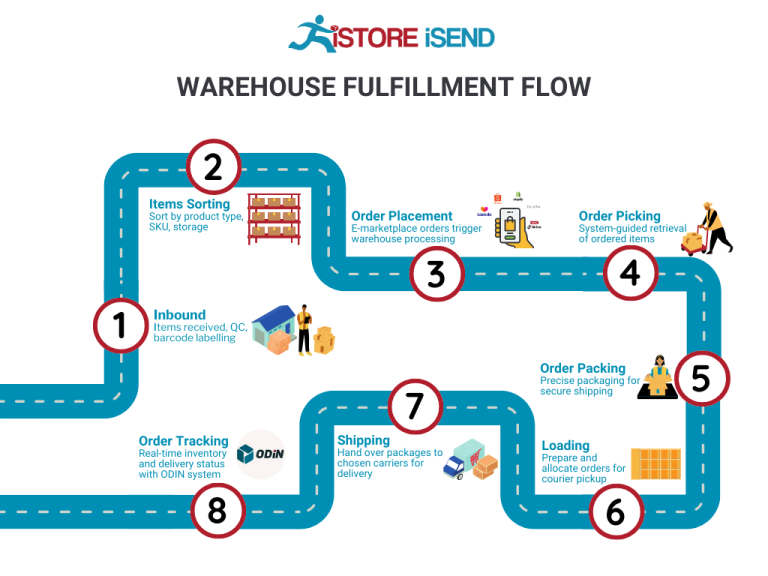
4. Order Packing
After items have been picked, they move to the packing stage. Here, products are securely packaged for shipment. This process involves selecting the appropriate packaging materials, such as boxes or padded envelopes, and including necessary documentation, such as packing slips and return labels. Key terms for this step include “dimensional weight pricing” and “packaging optimization.”
Effective order packing is essential for protecting products during transit and ensuring they arrive at the customer’s door in perfect condition. Properly packed items reduce the risk of damage, leading to higher customer satisfaction and lower return rates. Additionally, optimizing packaging can help reduce shipping costs, especially in a market where dimensional weight pricing can significantly affect overall shipping expenses.
5. Shipping & Delivery
The final step in the order fulfillment process is shipping and delivery. Once orders are packed, they are labeled and handed over to shipping carriers for delivery to customers. This stage involves choosing the most appropriate shipping method based on factors such as cost, speed, and destination. Key terms relevant to this phase include “last-mile delivery” and “tracking.”
Shipping and delivery are critical because they represent the final touchpoint with the customer. A smooth and timely delivery can enhance customer satisfaction and encourage repeat business. Providing tracking information allows customers to monitor their orders in real-time, adding transparency to the fulfillment process. Additionally, establishing strong relationships with reliable carriers can help ensure that delivery timelines are met, further solidifying your brand’s reputation for reliability.
In conclusion, understanding each step of the order fulfillment process is essential for e-commerce businesses looking to scale. By optimizing these operations, you can enhance customer satisfaction, reduce costs, and ultimately drive growth.
Comparing Fulfillment Models: In-House vs. 3PL vs. Dropshipping
Fulfillment Model Comparison
| Model | Who Handles Inventory | Best For (Business Stage) | Key Advantage | Key Disadvantage |
|---|---|---|---|---|
| In-House Fulfillment | Business itself | Established businesses with stable demand | Full control over inventory and fulfillment processes | High overhead costs and resource allocation |
| Third-Party Logistics (3PL) | Third-party provider | Growing businesses needing scalability | Reduced operational burden and flexibility | Less control over inventory and fulfillment processes |
| Dropshipping | Supplier or manufacturer | Startups and small businesses with limited capital | Low upfront investment and no inventory risk | Lower profit margins and reliance on supplier’s reliability |
In-House Fulfillment
In-house fulfillment involves managing the entire inventory and order processing within your own facilities. This model is typically best suited for established businesses with stable demand and sufficient resources to handle the logistics of storage, packing, and shipping. One of the key advantages of in-house fulfillment is the level of control it offers. Businesses can manage inventory closely, ensuring quality control and the ability to customize packaging and shipping methods to enhance brand identity. However, this model also comes with significant disadvantages, such as high overhead costs, including warehousing, labor, and technology investments. It requires a substantial commitment of resources, which can strain smaller operations or those with fluctuating sales volumes. Moreover, businesses must continuously manage staffing and operational efficiencies, which can divert focus from core business activities.
Third-Party Logistics (3PL)
Third-party logistics (3PL) involves outsourcing logistics functions to a specialized provider. This model is ideal for growing businesses that need to scale their operations without the burden of managing inventory and fulfillment in-house. A major advantage of 3PL is the flexibility it offers; businesses can adjust their logistics needs based on demand without making significant upfront investments in infrastructure. This can include warehousing, order processing, and shipping services, allowing for rapid scaling during peak times. Additionally, 3PL providers often have advanced technology and expertise in logistics, which can lead to more efficient operations. However, the downside is that businesses have less control over their inventory and fulfillment processes, which can impact customer experience. Inconsistent service from a 3PL provider can lead to delays or errors in order fulfillment, ultimately affecting brand reputation.
Dropshipping
Dropshipping is a fulfillment model where a business sells products without holding any inventory. Instead, when a product is sold, the order is forwarded to a third-party supplier who then ships the product directly to the customer. This model is particularly advantageous for startups and small businesses with limited capital, as it requires little to no upfront investment in inventory. The low-risk nature of dropshipping allows entrepreneurs to test various products and markets without significant financial commitment. However, dropshipping also comes with its share of challenges. Profit margins are often lower compared to other models, as suppliers typically charge higher prices for individual items. Additionally, businesses rely heavily on their suppliers for inventory management and shipping, which can lead to inconsistencies in product availability and delivery times. This reliance can create challenges in maintaining customer satisfaction, as any delays or issues with the supplier can directly affect the end customer’s experience.
Conclusion
Choosing the right fulfillment model is crucial for the success of an e-commerce business. Each model—In-House Fulfillment, Third-Party Logistics (3PL), and Dropshipping—has its unique advantages and disadvantages, making it essential to align the choice with the business’s current stage, operational capabilities, and strategic goals. By understanding the nuances of each model, business owners can make informed decisions that optimize their fulfillment processes, enhance customer satisfaction, and support scalable growth.
A Deep Dive into Amazon FBA: Pros, Cons, and Who It’s For
Understanding Fulfillment by Amazon (FBA)
Fulfillment by Amazon (FBA) is a service provided by Amazon that allows sellers to store their products in Amazon’s fulfillment centers. Amazon takes care of storage, packaging, and shipping of products directly to customers. This service not only streamlines the logistics process for sellers but also enhances customer experience by leveraging Amazon’s extensive distribution network.
When a customer places an order for a product that is fulfilled by Amazon, the process is seamless. Amazon handles the entire transaction—from picking and packing the product to shipping and providing customer service. This enables sellers to focus on growing their business while Amazon takes care of the operational complexities.
How FBA Works
-
Set Up Your FBA Account: To use FBA, sellers must first create an Amazon seller account and register for FBA.
-
Prepare Your Products: Sellers prepare their products according to Amazon’s guidelines. This includes labeling, packaging, and ensuring compliance with Amazon’s policies.
-
Ship Inventory to Amazon: Sellers send their inventory to Amazon’s fulfillment centers. Amazon provides guidance on where to ship products based on their algorithms to optimize storage and shipping.
-
Listing Products: Once the inventory is received, sellers list their products on Amazon. They can choose to fulfill orders through FBA or fulfill orders themselves.
-
Order Fulfillment: When a customer orders a product, Amazon takes over. They pick, pack, and ship the product on behalf of the seller. Customers benefit from Amazon’s fast shipping options, including Prime eligibility.
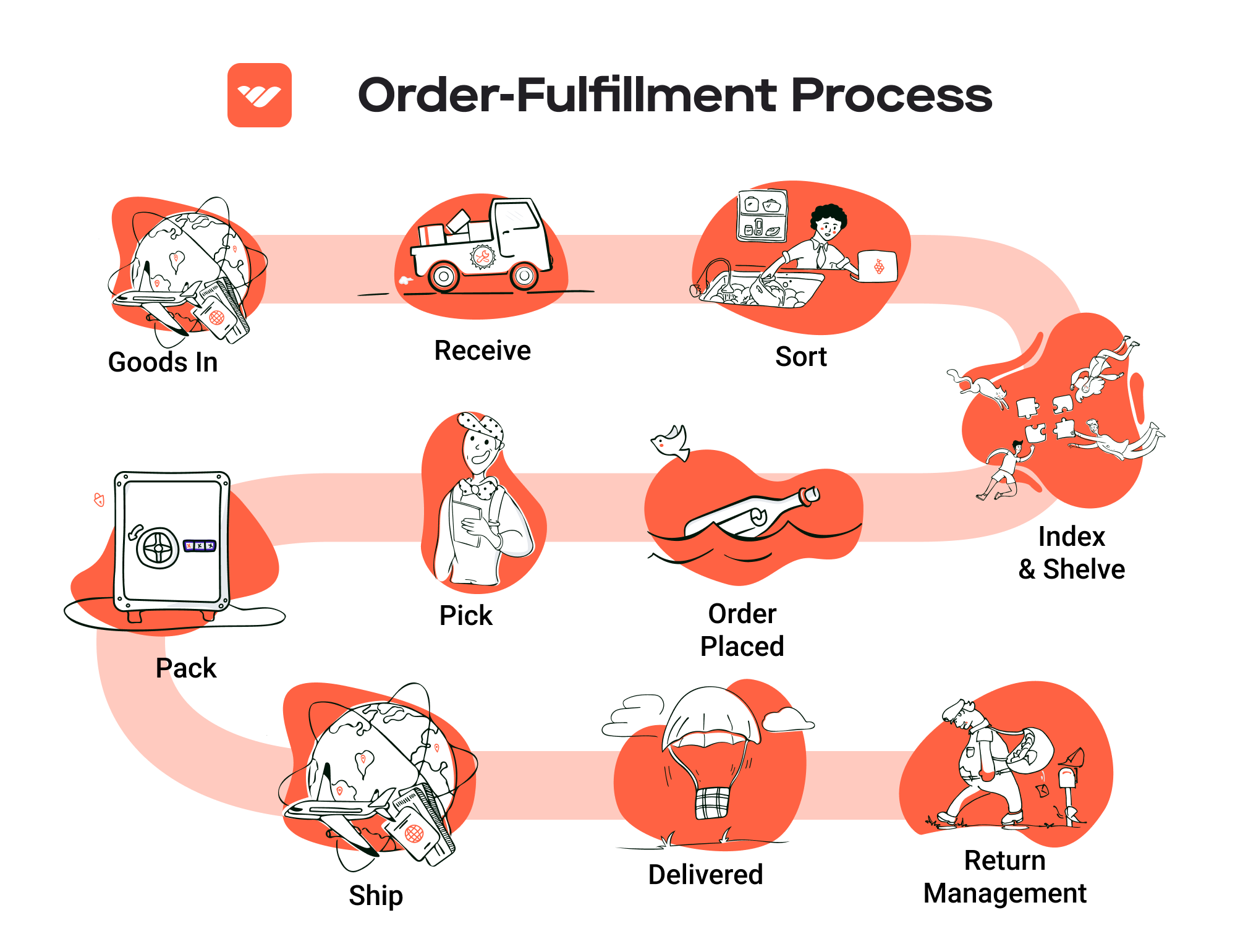
-
Customer Service and Returns: Amazon handles all customer inquiries, complaints, and return processing, ensuring a hassle-free experience for both sellers and buyers.
Pros of Using FBA
1. Prime Eligibility
One of the most significant advantages of FBA is that products become eligible for Amazon Prime. This means that sellers can tap into a massive customer base that values fast shipping and has a high level of trust in Amazon’s services. Prime members often prefer to purchase items that offer free two-day shipping, which can lead to increased sales for FBA sellers.
2. Enhanced Customer Trust
Selling through FBA enhances credibility and trust among customers. Amazon is a well-established brand, and customers often feel more secure purchasing products that are backed by Amazon’s fulfillment and customer service. This can lead to higher conversion rates and repeat purchases.
3. Multi-Channel Fulfillment
FBA is not limited to just Amazon’s marketplace. Sellers can use FBA to fulfill orders from other sales channels, such as their own websites or other e-commerce platforms. This multi-channel fulfillment capability allows sellers to centralize their logistics, making it easier to manage inventory and orders across various platforms.
4. Time-Saving
FBA significantly reduces the time and resources sellers need to spend on logistics. With Amazon handling storage, packing, and shipping, sellers can focus on other aspects of their business, such as marketing, product development, and customer engagement.
5. Scalable Operations
FBA allows sellers to scale their operations without the need to invest heavily in warehousing and logistics infrastructure. As sales increase, sellers can easily send more inventory to Amazon’s fulfillment centers.
Cons of Using FBA
1. High Fees
While FBA offers numerous advantages, it also comes with significant costs. Sellers must pay storage fees for inventory stored in Amazon’s warehouses and fulfillment fees for each item sold. These fees can add up quickly, especially for sellers with lower-margin products.
2. Strict Inventory Rules
Amazon has strict inventory management rules that sellers must adhere to. This includes limits on the amount of inventory that can be stored, which can be problematic for sellers with seasonal products or those with fluctuating demand.
3. Commingling Risks
FBA uses a process called commingling, where inventory from different sellers is stored together. This can lead to issues if a seller’s product is damaged or if counterfeit products are mixed in. Sellers may face challenges in tracking their specific inventory, which can affect their brand reputation.
4. Loss of Control
By using FBA, sellers relinquish some control over the fulfillment process. This can lead to potential issues with quality control, packaging, and branding, as Amazon determines how products are packaged and shipped.
5. Limited Customization
Sellers have limited options for customizing packaging and shipping processes. For brands that rely heavily on packaging for marketing and customer experience, this can be a significant drawback.
Who is FBA Best For?
Fulfillment by Amazon is best suited for e-commerce businesses looking to scale rapidly without the complexities of managing logistics. It is particularly advantageous for:
- New Sellers: Entrepreneurs who are just starting and want to leverage Amazon’s infrastructure to gain traction.
- Established Brands: Brands looking to increase their reach and sales through Amazon while minimizing operational overhead.
- High-Volume Sellers: Sellers with high sales volumes who can absorb FBA fees and benefit from the efficiency of Amazon’s fulfillment network.
- Multi-Channel Retailers: Businesses that sell on multiple platforms and want a centralized fulfillment solution.
In conclusion, while FBA offers numerous benefits that can significantly enhance an e-commerce business’s logistics capabilities, it is crucial for sellers to weigh these advantages against the associated costs and challenges. Understanding the nuances of FBA will enable businesses to make informed decisions about whether it aligns with their operational goals and customer service expectations.
Core Services Offered by Fulfillment Centers
Inventory Management & Warehousing
Inventory management and warehousing are foundational services offered by fulfillment centers, crucial for maintaining an efficient e-commerce operation. This service involves tracking inventory levels, managing stock locations, and ensuring that products are readily available for order fulfillment.
The benefit of effective inventory management cannot be overstated. For e-commerce businesses, it reduces the risk of stockouts and overstock situations, which can lead to lost sales or increased holding costs. By employing advanced inventory management systems, fulfillment centers provide real-time data on stock levels, enabling businesses to make informed decisions regarding reordering and inventory turnover. This results in optimized inventory levels, improved cash flow, and ultimately, enhanced customer satisfaction due to timely order fulfillment.
Pick and Pack Services
Pick and pack services are critical for e-commerce businesses that require efficient order processing. This service entails the selection (or “picking”) of products from the warehouse based on customer orders and the subsequent packaging (or “packing”) of those items for shipment.
The primary advantage of utilizing pick and pack services is the efficiency gained in order fulfillment. Fulfillment centers employ streamlined processes and technology to ensure that orders are picked accurately and quickly. This not only speeds up the shipping process but also minimizes errors that could lead to returns or customer dissatisfaction. For e-commerce businesses, faster order processing translates directly to improved customer experience, repeat business, and positive reviews, which are vital for scaling operations in a competitive market.
Kitting and Assembly
Kitting and assembly services involve the grouping of various products into a single kit or package, often requiring some assembly before shipping. This service is particularly beneficial for businesses that sell bundled products or promotional items.
The benefits of kitting and assembly extend beyond mere packaging convenience. By providing pre-assembled kits, e-commerce businesses can enhance the perceived value of their offerings, streamline their inventory processes, and reduce shipping costs. Fulfillment centers can efficiently handle these processes, allowing businesses to focus on marketing and sales rather than logistics. Additionally, kitting can lead to reduced time in order processing, as customers receive a ready-to-use product that requires no additional assembly on their part, thereby enhancing the overall customer experience.
Returns Management (Reverse Logistics)
Returns management, also known as reverse logistics, is a service that addresses the complexities involved in handling returned products. This includes managing the return process, inspecting returned items, restocking inventory, and processing refunds or exchanges.
For e-commerce businesses, effective returns management is critical to maintaining customer trust and satisfaction. A well-structured returns process can turn a potentially negative experience into a positive one, encouraging customers to shop again. Fulfillment centers that specialize in returns management offer streamlined processes that minimize the time and resources spent on handling returns. This service not only helps in recovering value from returned items but also provides valuable insights into customer preferences and product issues, enabling businesses to make informed decisions about inventory and product offerings.
In conclusion, leveraging the core services offered by fulfillment centers—inventory management and warehousing, pick and pack services, kitting and assembly, and returns management—enables e-commerce businesses to operate more efficiently, scale their operations, and enhance customer satisfaction. By outsourcing these critical logistics functions, businesses can focus on their core competencies, such as product development and marketing, ultimately driving growth and profitability in a competitive online marketplace.
How to Choose a Fulfillment Partner: A 6-Point Checklist
Location & Warehouse Network
Importance:
The location of your fulfillment partner’s warehouses can significantly impact shipping times, costs, and overall customer satisfaction. A strategically located warehouse network allows for faster delivery to your customers and lower shipping expenses.
Questions to Ask:
– Where are your warehouses located, and how does that relate to my customer base?
– Do you have multiple locations to ensure coverage across different regions?
– How do you handle shipping to international customers if my business expands globally?
Technology & Integrations
Importance:
In today’s digital age, a fulfillment partner’s technology stack is crucial for seamless operations. Robust technology can facilitate real-time inventory tracking, order management, and reporting. Additionally, integration with your existing e-commerce platform ensures a smooth flow of information.
Questions to Ask:
– What technology platforms do you use for order management and inventory tracking?
– Can your systems integrate with my existing e-commerce solutions (e.g., Shopify, WooCommerce)?
– Do you provide access to real-time data and analytics for my orders and inventory levels?
Specializations (e.g., Cold Storage, Oversized Items)
Importance:
If your product line includes specialized items, such as perishables or oversized goods, you need a fulfillment partner who can handle these specific requirements. Not all fulfillment centers have the capability or infrastructure to manage unique items.
Questions to Ask:
– What types of products do you specialize in handling?
– Do you have the necessary facilities for temperature-controlled storage if I sell perishable goods?
– How do you manage the storage and shipping of oversized or fragile items?
Scalability & Capacity
Importance:
As your business grows, your fulfillment partner must be able to scale operations accordingly. A partner with limited capacity may struggle during peak seasons, leading to delayed shipments and dissatisfied customers.
Questions to Ask:
– How do you handle fluctuations in order volume, such as during holiday seasons or promotions?
– What is your current capacity, and how quickly can you scale up operations if needed?
– Can you provide examples of how you managed scalability for other clients?
Pricing and Contracts
Importance:
Understanding the pricing structure is vital to ensure that your fulfillment costs align with your budget and profitability goals. Additionally, the terms of the contract should be clear to avoid unexpected fees or limitations.
Questions to Ask:
– What is your pricing model (e.g., per order, monthly fees, storage fees)?
– Are there any additional fees for services such as returns, packaging, or shipping?
– Can you provide a sample contract, including terms for cancellation or modifications?
Customer Support & Reviews
Importance:
Effective customer support is essential when issues arise. A fulfillment partner with excellent customer service can help resolve problems quickly, minimizing disruptions to your business. Additionally, reviews and testimonials can provide insight into the partner’s reputation.
Questions to Ask:
– What type of customer support do you offer (e.g., phone, email, chat)?
– How quickly can I expect a response to inquiries or issues?
– Can you provide references or case studies from other clients that highlight your customer service capabilities?
Conclusion
Choosing the right fulfillment partner is a critical decision for e-commerce business owners looking to scale their operations. By carefully evaluating potential partners against this checklist, you can ensure that you select a provider that aligns with your business needs, supports your growth, and enhances customer satisfaction. Remember, the ideal fulfillment partner will not only meet your current requirements but also adapt and grow with your business over time.
Understanding Fulfillment Pricing: A Breakdown of Common Fees
Initial Setup Fees
Initial setup fees are typically charged when you first engage a fulfillment service. This fee covers the costs associated with integrating your e-commerce platform with the fulfillment provider’s systems, including software setup, training, and onboarding. It may also include the costs of creating custom packaging or branding materials if applicable.
The calculation of initial setup fees can vary significantly between providers. Some may charge a flat rate, while others may base the fee on the complexity of your needs or the volume of products you plan to sell. On average, you might expect to pay anywhere from $500 to several thousand dollars, depending on the scale and customization required. When negotiating, be sure to clarify what services are included in this fee to avoid unexpected costs.
Receiving Fees
Receiving fees are charged when your products arrive at the fulfillment center. This fee covers the labor and resources required to unload, inspect, and log your inventory into the system.
Typically, receiving fees are calculated per shipment or per pallet, with costs ranging from $20 to $50 per pallet. Some fulfillment centers may also charge based on the number of units received, especially if you are sending a large quantity of small items. It’s essential to understand how your products will be received and processed to anticipate these costs accurately.
Storage Fees (per pallet/bin)
Storage fees are incurred for the space your inventory occupies within the fulfillment center. These fees are usually charged on a monthly basis, calculated per pallet or bin.
For pallets, storage fees can range from $10 to $30 per pallet per month, depending on the location and size of the warehouse. If you are storing smaller items that require bins, fees may be calculated per bin and can vary widely based on the provider’s pricing structure. Understanding your inventory turnover rate is crucial here; if your products move quickly, you may incur fewer storage costs, whereas slow-moving inventory can significantly increase your overhead.
Pick & Pack Fees (per item/order)
Pick and pack fees are charged for the labor involved in retrieving your products from storage and preparing them for shipment. This fee is typically calculated per item or per order, depending on the fulfillment provider’s structure.
On average, pick and pack fees range from $1 to $5 per item, with some providers offering bulk pricing for larger orders. The complexity of the order—such as whether it involves multiple items or special packaging—can also affect this fee. To minimize these costs, consider optimizing your product offerings and inventory management strategies to streamline the picking process.
Shipping Fees
Shipping fees are perhaps the most variable and can depend on several factors, including package size, weight, destination, and the shipping method chosen (standard, expedited, etc.). Fulfillment centers often have negotiated rates with carriers, which can lead to significant savings for your business.
Shipping fees can be calculated based on actual weight, dimensional weight, or a combination of both. Additionally, some fulfillment providers offer flat-rate shipping options for specific zones or package sizes. When evaluating shipping fees, consider the trade-offs between speed and cost, as well as the potential for offering free shipping to enhance customer satisfaction.
Tips for Getting an Accurate Quote
-
Be Transparent About Your Needs: Provide potential fulfillment partners with detailed information about your product types, order volumes, and specific requirements. The more accurate the information, the more precise the quote will be.
-
Request Itemized Quotes: Ask for a breakdown of all fees associated with the fulfillment process. An itemized quote will help you understand where your costs are coming from and allow for better budget management.
-
Compare Multiple Providers: Don’t settle for the first quote you receive. Comparing quotes from several fulfillment centers will give you a clearer understanding of the market rates and help you identify the best value for your business.
-
Inquire About Hidden Fees: Make sure to ask about any additional charges that might not be immediately apparent, such as fees for returns, special handling, or seasonal surcharges.
-
Consider Long-Term Relationships: If you anticipate significant growth, discuss the potential for volume discounts or long-term contracts that can reduce costs over time.
By understanding these common fulfillment pricing models and following these tips, you can make informed decisions that will help you scale your e-commerce business efficiently and cost-effectively.
Frequently Asked Questions (FAQs) about Fulfillment
1. What is fulfillment in e-commerce?
Fulfillment in e-commerce refers to the entire process of receiving, processing, and delivering orders to customers. This includes inventory management, order processing, packaging, shipping, and handling returns. Efficient fulfillment is crucial for customer satisfaction and overall business success.
2. What is the difference between a warehouse and a fulfillment center?
A warehouse is primarily a storage space for goods, where inventory is kept until needed. In contrast, a fulfillment center is specifically designed to manage the entire order fulfillment process, from receiving inventory to shipping orders directly to customers. Fulfillment centers often utilize advanced technology to streamline operations and enhance efficiency.
3. What is a Third-Party Logistics (3PL) provider?
A Third-Party Logistics (3PL) provider is a company that offers outsourced logistics services to businesses. This includes warehousing, fulfillment, transportation, and distribution. By partnering with a 3PL, businesses can leverage specialized expertise and technology to improve their supply chain efficiency without the overhead costs of managing these functions in-house.
4. How much do fulfillment services cost?
The cost of fulfillment services can vary widely depending on several factors, including order volume, storage needs, shipping destinations, and additional services required (like kitting or returns management). Typically, fulfillment costs are structured as a combination of storage fees, picking and packing fees, and shipping costs. Businesses should request detailed quotes from fulfillment providers to understand their specific pricing structure.
5. What are the benefits of using a fulfillment service?
Using a fulfillment service allows businesses to focus on core activities like marketing and product development while outsourcing logistics. Benefits include faster order processing, reduced shipping costs through bulk rates, access to advanced technology for inventory management, and improved scalability as business needs change.
6. How can I track my orders during fulfillment?
Most fulfillment providers, including Arrowhead Promotion and Fulfillment, offer real-time tracking systems that allow businesses and customers to monitor the status of orders throughout the fulfillment process. Tracking numbers are typically provided once an order has been shipped, enabling visibility from dispatch to delivery.
7. What role does technology play in fulfillment?
Technology plays a critical role in modern fulfillment processes. It enhances efficiency through automated inventory management, order processing, and data analytics. Advanced systems allow for real-time tracking, better demand forecasting, and streamlined communication between all parties involved, ultimately improving customer satisfaction.
8. How do you handle returns in the fulfillment process?
Returns management is a key component of fulfillment services. Providers like Arrowhead have established processes for handling returns, including providing return shipping labels, inspecting returned items, restocking inventory, and processing refunds or exchanges. A well-managed returns process can significantly enhance customer experience and loyalty.
9. What is kitting in fulfillment?
Kitting is the process of assembling individual items into a single, ready-to-ship package. This is often used for promotional bundles or customized orders where multiple products are packaged together. Fulfillment centers that offer kitting services can streamline the assembly process, saving time and improving efficiency for businesses.
10. How can I choose the right fulfillment partner?
Choosing the right fulfillment partner involves evaluating several key factors, including their technology capabilities, pricing structure, geographical reach, customer service quality, and experience in your specific industry. It’s essential to conduct thorough research, read client testimonials, and potentially request a trial period to assess their services before making a commitment.
Conclusion: Is Outsourcing Fulfillment the Right Move for Your Business?
The Benefits of Outsourcing Fulfillment
Outsourcing fulfillment can be a transformative decision for e-commerce businesses aiming for growth. One of the most significant advantages is the time savings it offers. By partnering with a specialized fulfillment service, you can redirect valuable resources away from logistics and focus on core business activities such as marketing, product development, and customer engagement. This shift not only enhances efficiency but also allows for more strategic decision-making.
Another critical benefit is scalability. As your business grows, so too does the complexity of managing orders, inventory, and shipping logistics. A dedicated fulfillment partner can provide the infrastructure and technology necessary to handle increased demand seamlessly. This flexibility enables you to respond to market trends and seasonal fluctuations without the burden of expanding your operational footprint.
Moreover, leveraging the expertise of a fulfillment service can significantly improve the overall customer experience. These providers often have advanced systems for inventory management, order tracking, and customer service, ensuring that your customers receive timely and accurate deliveries. Their experience in navigating logistics challenges can also mitigate risks and improve efficiency.
Choosing the Right Partner
While the benefits of outsourcing are clear, selecting the right fulfillment partner is critical for sustained growth. A partner that understands your industry and aligns with your business goals will be instrumental in scaling your operations effectively. Look for providers that offer customized solutions, robust technology platforms, and a proven track record of success.
Next Steps
To determine if outsourcing fulfillment is the right move for your business, conduct a thorough audit of your current shipping processes. Assess your operational pain points, customer satisfaction levels, and overall efficiency. This evaluation will help you identify areas where a fulfillment partner could add value, positioning your business for future growth. If you’re ready to explore your options, consider reaching out to a fulfillment specialist to discuss how they can help you streamline operations and scale effectively.
Important Disclaimer
⚠️ Important Disclaimer
The information in this guide is for educational purposes. Fulfillment services, pricing, and platform features change frequently. Always conduct your own due diligence and consult with providers directly before making business decisions.
